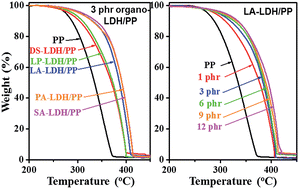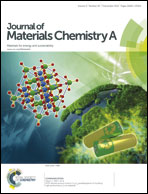Influence of anionic surface modifiers on the thermal stability and mechanical properties of layered double hydroxide/polypropylene nanocomposites†
Abstract
Organo-layered double hydroxide/polypropylene (LDH/PP) nanocomposites were successfully synthesized via a solution blending method. As an attempt to improve the compatibility with hydrophobic PP, the LDH surface was modified by the incorporation of various anionic surfactants via electrostatic interaction with LDH cationic layers. Surfactants were selected by considering the aliphatic carbon chain length (laurate, palmitate, stearate and dodecyl sulfate) and anionic functional groups (–COO−, –OPO32−, and –OSO3−) with the purpose of optimizing the homogeneous dispersion in the PP matrix. In PP nanocomposites containing LDH modified with alkyl carboxylate, the (00l) X-ray diffraction (XRD) peaks originating from organo-LDH were not observed, indicating that organo-LDH layers were fully exfoliated and homogeneously dispersed within the PP matrix, which were also confirmed by cross-sectional TEM analysis. However, PP nanocomposites containing LDH modified with dodecyl sulfate and lauryl phosphate showed broad (00l) XRD peaks, indicating that organo-LDH was partially exfoliated. According to the thermogravimetric analysis, the thermal stability (T0.5) of organo-LDH/PP nanocomposites was significantly improved by 37–60 K, depending on the type and loading content of organo-LDH compared to that of pristine PP. PP nanocomposites containing well-dispersed organo-LDH showed substantial enhancement of the elastic modulus with little decrease of tensile strength. These results are due to the increased interface volume fraction provided by the exfoliated LDH nanosheets.


 Please wait while we load your content...
Please wait while we load your content...